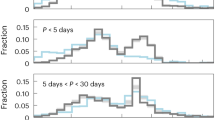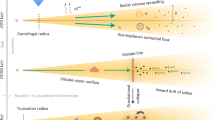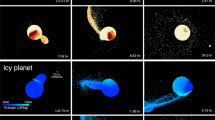Abstract
The Solar System's outer planets that contain hydrogen gas all host systems of multiple moons, which notably each contain a similar fraction of their respective planet's mass (∼10-4). This mass fraction is two to three orders of magnitude smaller than that of the largest satellites of the solid planets (such as the Earth's Moon), and its common value for gas planets has been puzzling. Here we model satellite growth and loss as a forming giant planet accumulates gas and rock-ice solids from solar orbit. We find that the mass fraction of its satellite system is regulated to ∼10-4 by a balance of two competing processes: the supply of inflowing material to the satellites, and satellite loss through orbital decay driven by the gas. We show that the overall properties of the satellite systems of Jupiter, Saturn and Uranus arise naturally, and suggest that similar processes could limit the largest moons of extrasolar Jupiter-mass planets to Moon-to-Mars size.
This is a preview of subscription content, access via your institution
Access options
Subscribe to this journal
Receive 51 print issues and online access
$199.00 per year
only $3.90 per issue
Buy this article
- Purchase on Springer Link
- Instant access to full article PDF
Prices may be subject to local taxes which are calculated during checkout




Similar content being viewed by others
References
Jewitt, D. & Sheppard, S. Irregular satellites in the context of planet formation. Space Sci. Rev. 116, 441–455 (2005)
Stevenson, D. J., Harris, A. W. & Lunine, J. I. in Satellites (eds Burns, J. A. & Matthews, M. S.) 39–88 (University of Arizona Press, Tucson, 1986)
Pollack, J. B., Lunine, J. I. & Tittemore, W. C. in Uranus (eds Bergstralh, J. T., Miner, E. D. & Matthews, M. S.) 469–512 (University of Arizona Press, Tucson, 1991)
Lunine, J. I., Coradini, A., Gautier, D., Owen, T. C. & Wuchterl, G. in Jupiter: The Planet, Satellites and Magnetosphere (eds Bagenal, F., Dowling, T. E. & McKinnon, W. B.) 19–34 (Cambridge University Press, Cambridge, UK, 2004)
Calvet, N., Hartmann, L. & Strom, S. E. in Protostars and Planets IV (eds Mannings, V., Boss, A. P. & Russell, S. S.) 377–399 (University of Arizona Press, Tucson, 2000)
Lubow, S. H., Seibert, M. & Artymowicz, P. Disk accretion onto high-mass planets. Astrophys. J. 526, 1001–1012 (1999)
Bate, M. R., Lubow, S. H., Ogilvie, G. I. & Miller, K. A. Three-dimensional calculations of high- and low-mass planets embedded in protoplanetary discs. Mon. Not. R. Astron. Soc. 341, 213–229 (2003)
Papaloizou, J. C. B. & Nelson, R. P. Models of accreting gas giant protoplanets in protostellar disks. Astron. Astrophys. 433, 247–265 (2005)
Canup, R. M. & Ward, W. R. Formation of the Galilean satellites: Conditions of accretion. Astron. J. 124, 3404–3423 (2002)
Ward, W. R. On disk-planet interactions and orbital eccentricities. Icarus 73, 330–348 (1998)
Artymowicz, P. Disk-satellite interaction via density waves and the eccentricity evolution of bodies embedded in disks. Astrophys. J. 419, 166–180 (1993)
Papaloizou, J. C. B. & Larwood, J. D. On the orbital evolution and growth of protoplanets embedded in a gaseous disc. Mon. Not. R. Astron. Soc. 315, 823–833 (2000)
Ward, W. R. Density waves in the solar nebula—Differential Lindblad torque. Icarus 67, 164–180 (1986)
Ward, W. R. Protoplanet migration by nebula tides. Icarus 126, 261–281 (1997)
Tanaka, H. & Ward, W. R. Three-dimensional interaction between a planet and an isothermal gaseous disk. II. Eccentricity waves and bending waves. Astrophys. J. 602, 388–395 (2004)
Tanaka, H., Takeuchi, T. & Ward, W. R. Three-dimensional interaction between a planet and an isothermal gaseous disk. I. Corotation and Lindblad torques and planet migration. Astrophys. J. 565, 1257–1274 (2002)
Ward, W. R. Density waves in the solar nebula—Planetesimal velocities. Icarus 106, 274–287 (1993)
Shakura, N. I. & Sunyaev, R. A. Black holes in binary systems. Observational appearance. Astron. Astrophys. 24, 337–355 (1973)
Duncan, M. J., Levison, H. F. & Lee, M. H. A multiple timestep symplectic algorithm for integrating close encounters. Astron. J. 116, 2067–2077 (1998)
Chambers, J. E., Wetherill, G. W. & Boss, A. P. The stability of multi-planet systems. Icarus 119, 261–268 (1996)
Lissauer, J. J. Urey Prize Lecture: On the diversity of plausible planetary systems. Icarus 114, 217–236 (1995)
Mosqueira, I. & Estrada, P. R. Formation of regular satellites of giant planets in an extended gaseous nebula I: Subnebula model and accretion of satellites. Icarus 163, 198–231 (2003)
Alibert, Y., Mousis, O. & Benz, W. Modeling the Jovian subnebula. I. Thermodynamic conditions and migration of proto-satellites. Astron. Astrophys. 439, 1205–1213 (2005)
Hubickyj, O., Bodenheimer, P. & Lissauer, J. J. Accretion of the gaseous envelope of Jupiter around a 5 to 10 Earth-mass core. Icarus 179, 415–431 (2005)
Slattery, W. L., Benz, W. & Cameron, A. G. W. Giant impacts on a primitive Uranus. Icarus 99, 167–174 (1992)
D'Angelo, G., Henning, T. & Kley, W. Thermodynamics of circumstellar disks with high-mass planets. Astrophys. J. 599, 548–576 (2003)
Ward, W. R. & Hamilton, D. P. Tilting Saturn. I. Analytic model. Astron. J. 128, 2501–2519 (2004)
Hamilton, D. P. & Ward, W. R. Tilting Saturn II. Numerical model. Astron. J. 128, 2510–2517 (2004)
Goldreich, P. Inclination of satellite orbits about an oblate precessing planet. Astron. J. 70, 5–9 (1965)
Brunini, A. Origin of the obliquities of the giant planets in mutual interactions in the early Solar System. Nature 440, 1163–1165 (2006)
Canup, R. M. & Ward, W. R. A possible impact origin of the Uranian satellite system. Bull. Am. Astron. Soc. 32, 1105 (2000)
Ward, W. R. & Canup, R. M. Viscous evolution of an impact generated disk around Uranus. Bull. Am. Astron. Soc. 35, 1046 (2003)
Goldreich, P., Murray, N., Longaretti, P. Y. & Banfield, D. Neptune's story. Science 245, 500–504 (1989)
McKinnon, W. B., Lunine, J. I. & Banfield, D. in Neptune and Triton (ed. Cruikshank, D. P.) 807–877 (University of Arizona Press, Tucson, 1995)
Agnor, C. B. & Hamilton, D. P. Neptune's capture of its moon Triton in a binary–planet gravitational encounter. Nature 441, 192–194 (2006)
Cuk, M. & Gladman, B. J. Constraints on the orbital evolution of Triton. Astrophys. J. 626, L113–L116 (2005)
Stevenson, D. J. Jupiter and its moons. Science 294, 71–72 (2001)
Williams, D. M. & Kasting, J. F. Habitable moons around extrasolar giant planets. Nature 385, 234–236 (1997)
Barnes, J. W. & O'Brien, D. P. Stability of satellites around close-in extrasolar giant planets. Astrophys. J. 575, 1087–1093 (2002)
Burrows, A., Hubbard, W. B. & Lunine, J. K. The theory of brown dwarfs and extrasolar giant planets. Rev. Mod. Phys. 73, 719–765 (2001)
Saumon, D. & Guillot, T. Shock compression of deuterium and the interiors of Jupiter and Saturn. Astrophys. J. 609, 1170–1180 (2004)
Anderson, J. D. et al. Shape, mean radius, gravity field, and interior structure of Callisto. Icarus 153, 157–161 (2001)
Johnson, T. V. & Lunine, J. I. Saturn's moon Phoebe as a captured body from the outer Solar System. Nature 435, 69–71 (2005)
Cassen, P. & Moosman, A. On the formation of protostellar disks. Icarus 48, 353–376 (1981)
Klahr, H. H. & Bodenheimer, P. Turbulence in accretion disks: vorticity generation and angular momentum transport via the global baroclinic instability. Astrophys. J. 582, 869–892 (2003)
Goodman, J. & Rafikov, R. R. Planetary torques as the viscosity of protoplanetary disks. Astrophys. J. 552, 793–802 (2001)
Lin, D. N. C. & Papaloizou, J. C. B. in Protostars and Planets III (eds Levy, E. H. & Lunine, J. I.) 749–835 (University of Arizona Press, Tucson, 1993)
Ward, W. R. & Hahn, J. in Protostars and Planets IV (eds Mannings, V., Boss, A. P. & Russell, S. S.) 1135–1155 (University of Arizona Press, Tucson, 2000)
Acknowledgements
This research was supported by NASA's Planetary Geology and Geophysics and Outer Planets Research programmes. Computer resources and support were provided by SwRI. We thank L. Dones, R. Mihran and S. Peale for comments.
Author information
Authors and Affiliations
Corresponding author
Ethics declarations
Competing interests
Reprints and permissions information is available at npg.nature.com/reprintsandpermissions. The authors declare no competing financial interests.
Supplementary information
Supplementary Notes
This file contains Supplementary Methods, Supplementary Notes and Supplementary Figures 1 and 2. (PDF 53 kb)
Rights and permissions
About this article
Cite this article
Canup, R., Ward, W. A common mass scaling for satellite systems of gaseous planets. Nature 441, 834–839 (2006). https://doi.org/10.1038/nature04860
Received:
Accepted:
Issue Date:
DOI: https://doi.org/10.1038/nature04860
This article is cited by
-
Large planets may not form fractionally large moons
Nature Communications (2022)
-
An exomoon survey of 70 cool giant exoplanets and the new candidate Kepler-1708 b-i
Nature Astronomy (2022)
-
Web of resonances and possible path of evolution of the small Uranian satellites
Astrophysics and Space Science (2022)
-
Enceladus as a potential oasis for life: Science goals and investigations for future explorations
Experimental Astronomy (2022)
-
Science Goals and Mission Objectives for the Future Exploration of Ice Giants Systems: A Horizon 2061 Perspective
Space Science Reviews (2021)
Comments
By submitting a comment you agree to abide by our Terms and Community Guidelines. If you find something abusive or that does not comply with our terms or guidelines please flag it as inappropriate.



